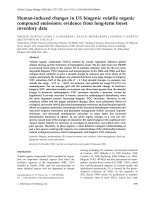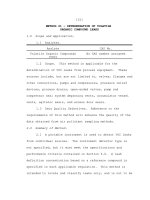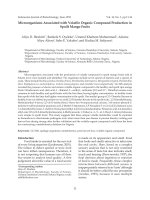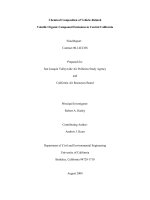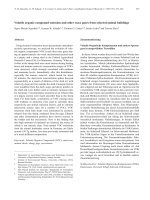Microorganisms Associated with Volatile Organic Compound Production in Spoilt Mango Fruits docx
Bạn đang xem bản rút gọn của tài liệu. Xem và tải ngay bản đầy đủ của tài liệu tại đây (379.38 KB, 6 trang )
I.J. Biotech.
11
Ibrahim et al.
Microorganisms Associated with Volatile Organic Compound Production in
Spoilt Mango Fruits
Aliyu D. Ibrahim
1*
, Bankole S. Oyeleke
3
, Ummul Khaltum Muhammad
1
, Adamu
Aliyu Aliero
2
, Sabo E. Yakubu
4
,
and Hadiza M. Sayanu
1
.
1
Department of Microbiology, Faculty of Science, Usmanu Danfodiyo University, Sokoto, Nigeria
2
Department of Biological Sciences, Faculty of Science, Usmanu Danfodiyo University, Sokoto-
Nigeria
3
Department of Microbiology, Federal University of Technology, Minna, Nigeria
4
Department of Microbiology, Faculty of Science, Ahmadu Bello University Zaria, .Nigeria
Abstract
Microorganisms associated with the production of volatile compound in spoilt mango fruits sold in
Sokoto town were isolated and identied. The organisms include seven species of bacteria and a species of
yeast. These include Bacillus pumilus, Bacillus rmus, Brevibacillus laterosporus, Morganella morganii, Paenibacillus
alvei, Staphylococcus saccharolyticus, Listeria monocytogenes and Candida krusei respectively. GC-MS analysis
revealed the presence of eleven and sixteen volatile organic compound in the healthy and spoilt ripe mango
fruits. Octadecanoic acid, oleic acid, 1 – Butanol, 3 – methyl-, carbonate (2:1) and 3,7 – Dimethyl nonane were
common to both healthy and spoilt fruits with the rst three having higher concentration in healthy fruits
than spoilt while the later had higher concentration in the spoilt. One methyl group of 3,3- Dimethyl hexane in
healthy fruit was shifted to position two to yield 2,3-Dimethyl hexane in the spoilt fruits. 2,2-Dimethylbutane,
Methyl(methyl-4-deoxy-2,3-di-O-methyl.beta.1-threo-hex-4-enopyranosid) urinate, 3-(4-amino-phenyl)-2-
(toluene-4-sulfonylamino)-propionic acid, 2-Methyl-3-heptanone, 3,5-Nonadien-7-yn-2-ol, (E,E), Butanoic acid,
1,1-dimethylethyl ester, 1-methyl-3-beta.phenylethyl-2,4,5-trioxoimidazolidine, Pentanoic acid, 2,2-dimethyl,
ethyl ester (Vinyl 2,2-dimethylpentanoate), 4-Methyurazole, 1-Tridecyn- 4 – 9 – ol, 1-Hexyl-1-nitrocyclohexane
were unique to spoilt fruits. This study suggests that these unique volatile metabolites could be exploited
as biomarkers to discriminate pathogens even when more than one disease is present thereby curbing post
harvest loss during storage after further validation and the volatile organic compound could form the basis
for constructing a metabolomics database for Nigeria.
Keywords : GC-MS, spoilage organisms, metabolomics, post harvest loss, volatile organic compound
Introduction
Food intake is essential for the survival
of every living organism (Lindemann, 2001).
The failure to detect spoiled or toxic food
can have lethal consequences. Therefore, it
is not surprising that humans use all their
ve senses to analyse food quality. A rst
judgement about the value of a food source
is made on its appearance and smell. Food
that looks and smells attractive is taken into
the oral cavity. Here, based on a complex
sensory analysis that is not only restricted
to the sense of taste but also includes smell,
touch and hearing (Drewnowski, 1997), the
nal decision about ingestion or rejection
of food is made. Frequently, these complex
interactions between different senses is
inappropriately referred to as ‘taste’ although
it should be better called avour perception
(Linden, 1993), because it uses multiple
senses.
Indonesian Journal of Biotechnology, June, 2011 Vol. 16, No. 1, pp.11-16
*Corresponding Author:
Aliyu D. Ibrahim
Department of Microbiology, Faculty of Science,
Usmanu Danfodiyo University, Sokoto, Nigeria, e-mail:
I.J. Biotech.
12
Ibrahim et al.
Microbial spoilage is manifested by a
variety of sensory cues such as off-colours, off-
odours, off- avours, softening of vegetables
and fruits, and slime. However, even before
it becomes obvious, microbes have begun
the process of breaking down food molecules
for their own metabolic needs. Sugars and
easily digested carbohydrates are used rst,
plant pectins are degraded. Then proteins are
attacked, producing volatile compounds with
characteristic smells such as ammonia, amines,
and sulfides. This may be accompanied by
the production of a wide range of metabolites
which includes: alcohols, sulphur compounds,
ketones, hydrocarbons, uorescent pigments,
organic acids, esters, carbonyls, and diamines.
Microbial product quality or shelf-life indicators
are organisms and/ or their metabolic products
whose presence in given foods at certain levels
may be used to assess existing quality or, better,
to predict shelf-life. These may be: the spoilage
organisms themselves, or their metabolic
products (Doyle, 2007).
Fruits are infected prior to harvest if
wounded by insects or other means or the
rot may progress from infected stems and
branches into the fruit. Postharvest infection
of fruit may occur through wounds made
during harvesting, transit or storage periods
or when warmer fruit are washed in cooler
contaminated water (Kucharek and Bartz,
2000). Early detection of spoilage would be
advantageous in reducing food loss because
there may be interventions that could halt or
delay deterioration, and on the other hand
food that had reached the end of its designated
shelf life but was not spoiled could still be
used. Numerous methods for detection of
spoilage have been devised with the goals
of determining concentrations of spoilage
microbes or volatile compounds produced
by these microbes. However, many of these
methods are considered inadequate because
they are time-consuming, labour-intensive,
and/or do not reliably give consistent
results (Doyle, 2007). This study is aimed at
isolating and identifying microorganisms
associated with spoilt mango fruits in Sokoto
metropolis; extract and identifying volatile
organic compounds associated with spoilt
sweet pepper using GC-MS.
Materials and Methods
Sample collection
Ten spoilt and healthy intact ripe
mango fruits were purchased from Gawon
Nama area in Sokoto metropolis. Samples
were collected into polythene bags and
immediately transported to the research
laboratory of Usmanu Danfodiyo University,
Sokoto for further analysis.
Isolation and count of microorganisms
Bacteria were isolated by transferring
an aliquot of 0.1 ml of a serially diluted (10
4
)
sample of spoilt mango fruits onto molten
nutrient agar plates and incubated at 37
o
C
for 24 hours. The colonies that emerge were
subculture continuously until a pure culture
is obtained. For fungi isolation an aliquot
of the mango fruits was inoculated onto
molten SDA plates and incubated at room
temperature for 7 days and was subculture
continuously to obtain pure culture.
Identication of bacteria and fungi
The bacteria isolate were identified
following series of biochemical test as
described by Holt et al. (1994). Yeast colonies
were studied by using Lactophenol Cotton
Blue Mount (LPCB) as described by Oyeleke
and Manga (2008).
Extraction of volatile metabolites
Volatile compounds were extracted
using general purpose solvent Parliment
(1997) as described by Ibrahim et al. (2011).
Extraction of volatile compounds was done
by direct solvent extraction method. Two
gram of spoilt mango fruits and healthy ripe
mango fruits was weighed into a bottle and
saturated with 20 ml of diethyl ether. It was
allowed to stand at room temperature for 24
h, ltered using Whatman No. 1 lter Paper
and the ltrate was collected in a sterile bottle,
closed tightly before the GC-MS analysis.
I.J. Biotech.
13
Ibrahim et al.
Gas chromatography mass spectrometry
(GC-MS) analysis
GC-MS analysis was performed using
GC-MS-QP2010 plus (Shimadzu, Japan)
equipped with flame ionization detector
(FID). The injection was conducted in split
less mode at 250
0
C for 3min by using
an inlet of 0.75 mm i.d to minimize peak
broadening. Chromatographic separations
were performed by using DB-WAX analytical
column 30 m 0.25 mm, 0.25mm (J&W
scientic, Folsom C.A) with helium as carrier
gas at a constant ow rate of 0.8 ml/min.
The oven temperature was programmed at
60
o
C for 5min, followed by an increase (held
for 5 min), and nally at 10
0
C/min to 280
o
C
(held for 10 min). The temperature of the FID
was set to 250
o
C. MS operating conditions
(electron impact ionization mode) were an
ion source temperature of 200
o
C, ionization
voltage of 70 eV and mass scan range of m/z
23- 450 at 2.76 scans/s.
Identication and quantication of volatile
metabolites
The chromatographic peak identication
was carried out by comparing their mass
spectra with those of the bibliography data
of unknown compounds from the NIST
library mass spectra database on the basis
of the criterion similarity (SI)>800 (the
highest value is 1,000). According to the
method of (Wanakhachornkrai and Lertsiri,
2003) approximate quantication of volatile
compounds was estimated by the integration
of peaks on the total ion chromatogram using
Xcalibur software (Vienna, VA). The results
are presented as the peak area normalized
(%).
Results
The microbial flora associated with
volatile organic compound during spoilage
of mango fruits were isolated and identied
as seven species of bacteria and a species of
yeast. These include Bacillus pumilus, Bacillus
rmus, Brevibacillus laterosporus, Morganella
morganii, Paenibacillus alvei, Staphylococcus
Table 2: Result of GC-MS analysis of healthy and spoilt
mango fruits
RT
(mm)
Compounds
Peak Area (%)
Healthy Spoilt
3.84 4 - Methyl octane 7.03 -
3.85 2,2-Dimethyl butane - 4.16
4.64 Methyl(methyl-4-deoxy-
2,3-di-O-methyl.beta.1-
threo-hex-4-enopyranosid)
urinate
- 1.51
5.13 3-(4-amino-phenyl)-2-
(toluene-4-sulfonylamino)-
propionic acid
- 1.82
6.36 3,3 – Dimethyl hexane 5.85 -
6.37 2-Methyl-3-heptanone - 4.35
9.67 3,7-Dimethyl nonane 4.99 5.77
11.02 1-Butanol, 3-Methyl-,
Carbonate (2:1)
5.32 4.16
12.25 3,5-Nonadien-7-yn-2-ol,
(E,E)
- 1.93
12.98 Butanoic acid, 1,1-
dimethylethyl ester
- 0.69
14.19 1-methyl-3-beta.
phenylethyl-2,4,5-
trioxoimidazolidine
- 0.84
14.92 Allyl heptanoate
(Heptanoic acid, 2-
propenyl ester)
2.70 -
14.93 Pentanoic acid, 2,2-
dimethyl, ethyl
ester (Vinyl 2,2-
dimethylpentanoate)
- 1.39
18.02 Naphthalane, 1-methyl (1-
Methyl Naphthalane)
2.29 -
18.04 2,3-Dimethyl hexane - 3.24
18.46 4-Methyurazole - 2.26
27.61 Octadecanoic acid 32.39 30.47
28.77 Oleic acid 29.13 27.18
29.66 1-Tridecyn- 4 – 9 – ol - 3.67
29.66 Dodecanoyl chloride
(Lauric acid, chloride)
2.65 -
30.66 1-Hexyl-1-
nitrocyclohexane
- 5.07
30.82 Hexadecanoic acid, 1-[[[2-
amino ethoxy) hydroxyp
hoshinyl]oxy]methyl]-1,2-
ethanediyl ester
2.86 -
31.20 1- Heptadecyne 3.12 -
1
Retention time (RT) on DB-WBX column in GC-MS.
I.J. Biotech.
14
Ibrahim et al.
saccharolyticus, Listeria monocytogenes and
Candida krusei respectively.
The result of GC-MS analysis of diethyl
ether extract obtained from healthy and
spoilt mango revealed the presence of 11
and 16 compounds (Table 2), dominated
among them are octadecanoic acid (32.39 and
30.47%), Oleic acid (29.1 and 27.18%) and a
decrease in concentration of these dominant
compounds were noticed in spoilt mango
fruits which Butanoic acid, 1,1-dimethylethyl
ester (0.69%) as the compound with the least
value.
Discussion
The microbial flora associated with
volatile organic compound during spoilage of
mango fruits include Bacillus pumilus, Bacillus
rmus, Brevibacillus laterosporus, Morganella
morganii, Paenibacillus alvei, Staphylococcus
saccharolyticus, Listeria monocytogenes and
Candida krusei respectively. The source of
these organisms could probably from soil, the
fruits themselves, the harvesting/ packaging
containers, mango handlers, air and dust (Jay
et al., 2005). Mango fruits from Tashar Illela
may not be safe for consumption as they may
cause gastroenteritis because of the presence
of Listeria monocytogenes. This result is in
contrary to most authors as no Pseudomonas
spp was isolated and the prevailing genera in
this work are gram positive organism of the
Bacillus genus. This probably is explained by
the fact that Bacillus spp are able to overcome
some of the intrinsic and extrinsic parameters
that could have check their population due
to their ability to form spores.
Several compounds were unique
to disease mango fruits, which could be
qualitatively used to discriminate disease
fruits. Butanoic acid, 1,1-dimethylethyl
ester, 2,2-Dimethylbutane, Methyl(methyl-
4-deoxy-2,3-di-O-methyl.beta.1-threo-
hex-4-enopyranosid) urinate, 3-(4-amino-
phenyl)-2-(toluene-4-sulfonylamino)-
propionic acid, 2-Methyl-3-heptanone,
3,5-Nonadien-7-yn-2-ol, (E,E), 1-methyl-3-
beta.phenylethyl-2,4,5-trioxoimidazolidine,
Pentanoic acid, 2,2-dimethyl, ethyl
ester (Vinyl 2,2-dimethylpentanoate), 4-
Methyurazole, 1-Tridecyn- 4 – 9 – ol, 1-
Hexyl-1-nitrocyclohexane were unique to
spoilt fruits. These unique metabolites can
be used as biomarkers to detect the presence
of the pathogens detected in this study. 4 -
Methyl octane, 3,3 – Dimethyl hexane, Allyl
heptanoate (Heptanoic acid, 2- propenyl
ester), Naphthalane, 1-methyl (1-Methyl
Naphthalane), Dodecanoyl chloride (Lauric
acid, chloride), Hexadecanoic acid, 1-[[[2-
amino ethoxy) hydroxyphoshinyl]oxy]meth
yl]-1,2-ethanediyl ester and 1- Heptadecyne
were unique to healthy mango fruits. 4 -
Methyl octane was detected in green coffee
(Gonzalez-Rios et al., 2006). These unique
metabolites can be used as biomarkers to
detect the presence of the pathogens detected
in this study.
Four volatile organic compound were
unique to healthy and spoilt mango fruits
which include 3, 7-Dimethyl Nonane (4.99;
5.77%), 1-Butanol, 3-Methyl-, Carbonate
(2:1) 5.32; 4.16%, octadecanoic acid (32.39;
30.47%) and oleic acid (29.13; 27.18%).
However, a reduction was observed in
the concentration of 1-Butanol, 3-Methyl-,
Carbonate (2:1), octadecanoic acid and oleic
acid The presence and/or absence of the
above volatile organic compounds and the
differences in their relative abundance could
be considered for qualitative discrimination
of healthy and spoilt mango fruits especially
when unique compounds are absent and
mixed infections, especially in the same
lesion, are present. Similar result has been
observed by Moalemiyan et al. (2006), that
certain volatile metabolites were common
to stem-end rot and anthracnose diseases of
mango fruits.
The fatty acids detected in the spoilt and
healthy fruits are octadecanoic acid and oleic
acid. The hydroxyl form of 9- Octadecenoic
acid (Z) that is hydroxy fatty acids (HFA)
have been described as multifunctional
molecules that have a variety of applications
(Bódalo et al., 2005), and they and their
I.J. Biotech.
15
Ibrahim et al.
derivatives are used in cosmetics, paints
and coatings, lubricants and in the food
industry (Bódalo et al., 2005). They are useful
chemical intermediates in the synthesis of ne
chemicals and pharmaceuticals (Bódalo et al.,
2005). Moreover, some of them may protect
plants against microbial infection, although
the mechanism of these antimicrobial effects
is poorly understood (Suzuki et al., 2005).
The reduction in the relative abundance
of octadecanoic acid and oleic acid might
be that the microorganisms present in the
spoilt mango fruits have converted them
to other volatile compounds (Bódalo et al.,
2005; Rodríguez, 2001). The importance of
these esters has been describe to contribute to
food aroma with the fact that esters with low
carbon atoms are highly volatile at precursors
(Izco and Torre, 2000; Nogueira et al., 2005). In
addition to imparting a fruity oral character,
esters can diminish or mask the sharpness
of unpleasant free amino acid-derived notes
(Yanfang and Wenyi, 2009).
In conclusion, this st u dies on
microorganisms associated with volatile
organic compound production that spoilt
mango fruits sold in Tashar Illela contain
organisms such as Bacillus pumilus, Bacillus
rmus, Brevibacillus laterosporus, Morganella
morganii, Paenibacillus alvei, Staphylococcus
saccharolyticus, Listeria monocytogenes and
Candida krusei respectively. Hence spoilt
mango fruits from this market may not
safe for consumption. The study revealed
the presence of eleven and sixteen volatile
organic compound in the healthy and spoilt
ripe mango fruits. Octadecanoic acid, oleic
acid, 1 – Butanol, 3 – methyl-, carbonate (2:1)
and 3,7 – Dimethyl nonane were common
to both healthy and spoilt fruits with the
rst three having higher concentration in
healthy fruits than spoilt while the later
had higher concentration in the spoilt. One
methyl group of 3,3- Dimethyl hexane in
healthy fruit was shifted to position two
to yield 2,3-Dimethyl hexane in the spoilt
fruits. 2,2-Dimethylbutane, Methyl(methyl-
4-deoxy-2,3-di-O-methyl.beta.1-threo-
hex-4-enopyranosid) urinate, 3-(4-amino-
phenyl)-2-(toluene-4-sulfonylamino)-
propionic acid, 2-Methyl-3-heptanone,
3,5-Nonadien-7-yn-2-ol, (E,E), Butanoic
acid, 1,1-dimethylethyl ester, 1-methyl-3-
beta.phenylethyl-2,4,5-trioxoimidazolidine,
Pentanoic acid, 2,2-dimethyl, ethyl
ester (Vinyl 2,2-dimethylpentanoate), 4-
Methyurazole, 1-Tridecyn- 4 – 9 – ol, 1-
Hexyl-1-nitrocyclohexane were unique
to spoilt fruits. This study suggests that
these unique volatile metabolites could be
exploited as biomarkers to discriminate
pathogens even when more than one disease
is present thereby curbing post harvest loss
during storage after further validation and
the volatile organic compound could form
the basis for constructing a metabolomics
database for Nigeria.
References
Bódalo, A.; Bastida, J.; Máximo, M.F.; Hidalgo
A.M. and Murcia M.D. 2005. Production
of (E) 10-hydroxy-8-octadecenoic acid
with lyophilized microbial cells. Amer.
J. Biochem. Biotechnol., 1(1), 1-4.
Doyle, M. E. 2007. Microbial Food Spoilage
- Losses and Control Strategies: A
Brief Review of the Literature. Food
Research Institute Briengs. University
of Wisconsin–Madison
Drewnowski, A. 1997. Taste preferences and
food intake. Annu Rev Nutr, 17:237-53.
Gonzalez-Rios, O., Suarez-Quiroz, M. L.
Boulanger, R., Barel, M., Guyot, B.,
Guiraud, J-P., and Schorr-Galindo,
S. 2006. Impact of ‘‘ecological’’ post-
harvest processing on the volatile
fraction of coffee beans: I. Green
coffee
Holt, J. G.; Krieg, N. R.; Sneath, P. H. A.;
Staley J. T. and Williams S. T. 1994.
Bergy’s Manual of Determinative
Bacteriology.9
th
Ed. Williams and
Wilkins. Pp. 478-529.
Ibrahim, A.D.; Sani, A., Manga, S.B.; Aliero,
A.A.; R.U. Joseph, Yakubu, S.E. and
Ibafidon, H. 2011. Microorganisms
I.J. Biotech.
16
Ibrahim et al.
Associated with Volatile Metabolites
Production in Soft Rot Disease of Sweet
Pepper Fruits (Tattase) Int. J. Biotechnol.
Biochem. 7(6), 25–35
Izco J. M and Torre, P. 2000. Characterization
of volatile avour compounds in Roncal
cheese extracted by the ‘purge and trap’
method and analysed by GC-MS. Food
Chem. 70, 409–417.
Jay, M. J.; Loessner, J. M and Golden, A.D.
2005. Modern food microbiology, 7
th
ed. Springer science, New York, USA.
Pp 17- 54
Kucharek, T., and Bartz, J. 2000. Bacterial soft
rots of vegetables and agronomic crops.
Univ. of Fla. Coop. Ext. Serv. Fact Sheet
(Plant Pathology) No. PP-12.
Linden, RW. 1993. Taste, British Dental
Journal 175: 243-253. doi:10.1038/
sj.bdj.4808291Lindemann, B., 2001.
Receptors and transduction in taste.
Nature. 413, 219-225.
Moalemiyan, M., Vikram A, Kushalappa A.
C. Yaylayan V. 2006. Volatile metabolite
profiling to detect and discriminate
stem-end rot and anthracnose diseases
of mango fruits.Plant Pathology, 55 (6)
, 792–802
Nogueira, M.C.L., Lubachevsky, G., Rankin,
S.A. 2005. A study of the volatile
composition of Minas cheese. Lebensm
Wiss. Technol, 38, 555-563.
Oyeleke, S.B. and Manga, S.B. 2008. Essentials
of laboratory practical in microbiology.
Tobest publishers, Minna. Nigeria. Pp.
33-34.
Parliment, T.H. 1997. Solvent extraction and
distillation techniques In: Marsili, R. (E).
Techniques for Analyzing food Aroma.
Marcel Dekker. New York. Pp. 1 – 27.
Rodríguez, E., M.J. Espuny, A. Manresa and
A. Guerrero, 2001. Identication of (E)-
11-hydroxy-9-octadecenoic acid and
(E)-9-hydroxy-10-octadecenoic acid
by biotransformation of oleic acid by
Pseudomonas sp. 32T3. J. Am. Oil Chem.
Soc.,78,593-597.
Suzuki, Y., O. Kurita, Y. Kono, H. Hyakutake
and Sakurai, A. 2005. Structure of a
new antifungal C11-hydroxy fatty acid
isolated from leaves of wild rice (Oryza
ofcinalis). Biosci. Biotechnol. Biochem.,
59, 2049-2051.
Wanakhachornkrai, P and Lirtsiri, S. 2005.
Comparison of determination method
for volatile compounds in Thai soy
sauce. Food Chem., 83, 619-629.
Yanfang, Z and Wenyi, T. 2009. Flavour and
taste compounds analysis in Chinese
solid fermented soy sauce. Afr. Jour.
Biotechnol. 8(4), 673-681

